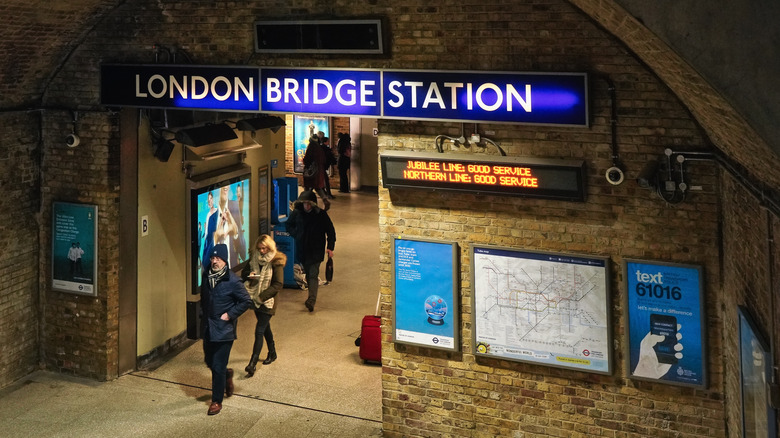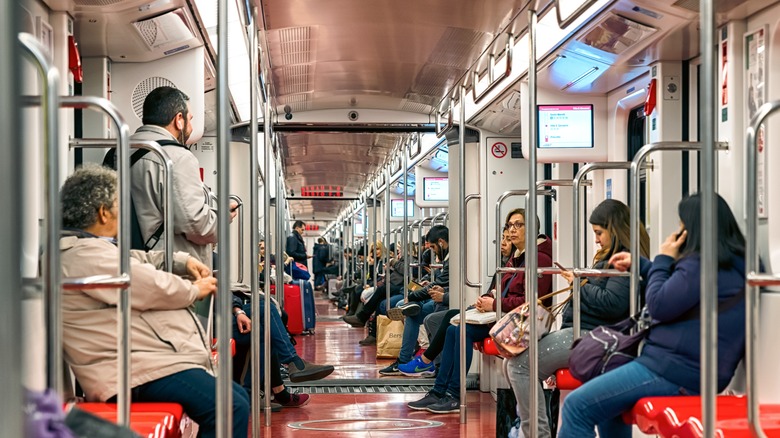The Secret To Sightseeing In Europe As Efficiently As Possible, Per Rick Steves
Europe is home to many civilizations' greatest inventions. From the printing press in 1440 to cars, computers, and television — the list goes on — they all still serve their primary purpose worldwide today. However, beneath all of Europe's grand wonders, there is one invention that's overlooked and hidden underground. According to travel expert Rick Steves, this secret is none other than the metro or subway, and it'll make sightseeing in Europe as efficient as possible.
Those in other countries might be more familiar with terms like U-bahn (Germany and Austria), Metropolitana (Italy), and Tube (London). This world-changing transport system originated in London and was pitched by Charles Pearson in 1843. It was put to use in 1863, running for 4 miles across seven stations between Paddington and Farringdon Street. The plan was to alleviate some of London's street traffic, which would have been horse, carriage, and pedestrian at the time, as automobiles were not invented until 1886. Nevertheless, the need was imminent; after two years of construction, it was ready to operate, and the rest is history.
The benefits of using subway systems in Europe include an indisputable track record (no pun intended) when it comes to efficiency since you never have to deal with dense traffic jams. Also, it is an experience of cultural immersion that no other method of transportation offers. And it happens to be the most affordable! For those traveling through Europe with kids, riding this piece of history is a "no-trainer" (this time, pun intended).
Tips on how to use the subway efficiently
Riding trains in Europe is like riding a bicycle; once you learn how, you can never forget it. With Rick Steves' tips, some know-how, and a train ticket, there is no going back to inefficient alternatives. It's important to know before arriving at a European metro that, unlike trains, there isn't usually a strict schedule. Instead, services run frequently from 6:00 a.m. to midnight, making it convenient to explore at your own pace.
Next, familiarize yourself with the metro lines by studying the map. Some European cities have much more complicated systems with over 12 lines, like the pioneering London Tube. You can find these within the station, on the train, and online — on sites like Metro Line Map or through a quick Google search. However, it's a good idea to cross-reference the map with the one at the station upon arrival, just in case of any recent changes.
Next, ensure that you have validated your ticket, whether you have a travel pass or a paper ticket. Failure to do so will result in a fine (up to €200) if you're caught. Rick Steves recommends observing what others are doing or asking staff members for help if you need clarification. Typically, a validated ticket will have a timestamp on it. Never throw away your metro ticket! If you have a multi-day pass, you might only need to validate once, but better safe than sorry.
Etiquette and navigation
Remember, you're still in a foreign country, and there are unwritten rules everywhere you go, even underground in the metro. By following these rules, you can consider yourself safe from the scorn of locals, earning your right to remain efficient on your European travels. First, while on escalators, always stand on the right-hand side, leaving room for passing on the left. This is a widely respected rule across Europe, even in countries where the left-hand side is the customary side for travel.
When the train arrives, avoid eagerly waiting in front of the metro doors, as this blocks those exiting the train. It's expected etiquette to allow all passengers to disembark first, and then you can enter and look for a convenient spot. While on the train, keep noise levels to a minimum, at least no louder than any local European on board. On some subways, like the Tube, taking off your backpack is common courtesy.
But what good is any of this efficiency without proper navigation tools and skills? It's crucial to have your route planned, just in case you find yourself in an unlucky situation or without an Internet connection. For those in major cities, use resources like Citymapper or Google Maps (tip: ensure you have the offline map downloaded). Rick Steves recommends the CityMaps2Go and HERE WeGo apps, which work both online and offline. Stay on the right track, use the metro, do as Rick Steves does, and see Europe as efficiently as possible.


